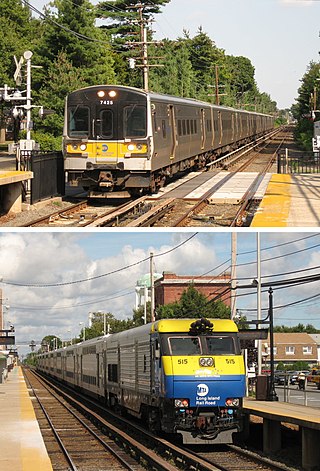
The Long Island Rail Road, often abbreviated as the LIRR, is a railroad in the southeastern part of the U.S. state of New York, stretching from Manhattan to the eastern tip of Suffolk County on Long Island. The railroad currently operates a public commuter rail service, with its freight operations contracted to the New York and Atlantic Railway. With an average weekday ridership of 354,800 passengers in 2016, it is the busiest commuter railroad in North America. It is also one of the world's few commuter systems that runs 24/7 year-round. It is publicly owned by the Metropolitan Transportation Authority, which refers to it as MTA Long Island Rail Road. In 2022, the system had a ridership of 70,342,700, or about 253,800 per weekday as of the third quarter of 2023.

MTA Construction and Development Company is a subsidiary of the Metropolitan Transportation Authority (MTA), formed in July 2003 as MTA Capital Construction Company to manage the MTA's major capital projects in the New York metropolitan area. It mainly focuses on improving transportation infrastructure and facilities in New York City, the Hudson Valley, and Long Island areas. Funding primarily comes from local, state, and national bond sales and budgets. In 2017 Janno Lieber became MTA Capital Construction president; in 2021 he was appointed Acting Chair of the MTA.

The Port Jefferson Branch is a rail line and service owned and operated by the Long Island Rail Road in the U.S. state of New York. The branch splits from the Main Line just east of Hicksville and runs northeast and east to Port Jefferson. Several stations on the Main Line west of Hicksville are served primarily by trains bound to/from the Port Jefferson branch, so LIRR maps and schedules for the public include that part of the Main Line in the "Port Jefferson Branch" service.
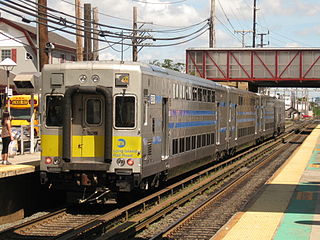
The Oyster Bay Branch is a rail line and service owned and operated by the Long Island Rail Road in the U.S. state of New York. The branch splits from the Main Line just east of Mineola station, and runs north and east to Oyster Bay. The branch is electrified between East Williston and Mineola. The branch opened in segments between 1865 and 1889.
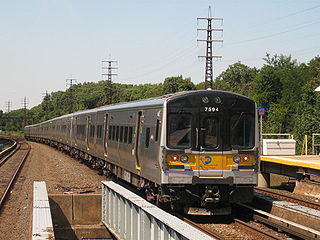
The Long Beach Branch is an electrified rail line and service owned and operated by the Long Island Rail Road in the U.S. state of New York. The branch begins at Valley Interlocking, just east of Valley Stream station, where it merges with the Far Rockaway Branch to continue west as the Atlantic Branch. East from there the Long Beach Branch parallels the Montauk Branch to Lynbrook station, where it turns south toward Long Beach station. Trains operating on the Long Beach Branch continue west of Valley Stream via the Atlantic Branch to Jamaica station, with most continuing on to Grand Central or Penn Station in Midtown Manhattan. In 2018, the branch recorded an annual ridership of 4,849,085 based on ticket sales, down 1% from 2017.
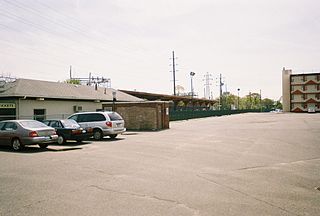
The West Hempstead Branch is an electrified rail line owned and operated by the Long Island Rail Road (LIRR) in the U.S. state of New York. It runs between Valley Stream, New York, and West Hempstead, New York.

The Hempstead Branch is an electrified rail line and service owned and operated by the Long Island Rail Road in the U.S. state of New York. The branch begins at the Main Line at Queens Interlocking, just east of Queens Village station. It parallels the Main Line past Bellerose to Floral Park, where it splits southward and continues east via the village of Garden City to Hempstead Crossing. There it turns south to the final two stations, Country Life Press and Hempstead.

The Mineola Intermodal Center is an intermodal center and transportation hub in the village of Mineola, New York. It contains the Mineola Long Island Rail Road station – one of the railroad's busiest stations – in addition to one of the Nassau Inter-County Express bus system's main hubs, located adjacent to the southern train platform.

Westbury is a station on the Long Island Rail Road's Main Line. All trains for the Port Jefferson Branch and Ronkonkoma Branch run through it, though only some trains on the Port Jefferson branch stop. It is located at Union and Post Avenues in Westbury, New York. It is 23.4 miles (37.7 km) from Penn Station. The station is fully wheelchair accessible. It has two side platforms and three tracks.

The Central Branch is a rail line owned and operated by the Long Island Rail Road (LIRR) in the U.S. state of New York, extending from 40.734°N 73.470°W just east of Bethpage station to 40.696°N 73.341°W just west of Babylon station. It was built in 1873 as part of the Babylon Extension of the Central Railroad of Long Island (CRRLI), which was owned by Alexander Turney Stewart. The branch was mostly unused following the 1876 merger of the CRRLI and the LIRR, but in 1925 it was rebuilt and reconfigured to connect Bethpage and Babylon stations.
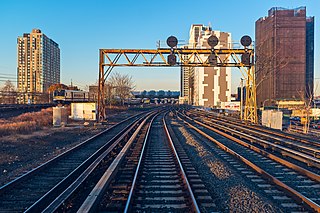
The Main Line is a rail line owned and operated by the Long Island Rail Road in the U.S. state of New York. It begins as a two-track line at Long Island City station in Long Island City, Queens, and runs along the middle of Long Island about 95 miles (153 km) to Greenport station in Greenport, Suffolk County. At Harold Interlocking approximately one mile east of Long Island City, the tracks from the East River Tunnels and 63rd Street Tunnel into Manhattan intersect with the Main Line, which most trains use rather than continuing to Long Island City station.

Ronkonkoma is a major railroad station and transportation hub along the Main Line of the Long Island Rail Road in Ronkonkoma, New York. The station is the eastern terminus of the Ronkonkoma Branch and the western terminus of the Greenport Branch.
The Long Island Rail Road is a railroad owned by the Metropolitan Transportation Authority in the U.S. state of New York. It is the oldest United States railroad still operating under its original name and charter. It consolidated several other companies in the late 19th century. The Pennsylvania Railroad owned the Long Island Rail Road for the majority of the 20th century and sold it to the State in 1966.

Yaphank is a station in the hamlet of Yaphank, New York on the Main Line of the Long Island Rail Road. It is located on Park Street near Suffolk County Road 21. It is also accessible from streets in and around Suffolk County. The distance between Yaphank and the next station, Riverhead, is the longest distance between stations in the LIRR at 14.7 miles (23.7 km). Government buildings are located on the north side of the tracks at the bottom of the Yaphank Avenue overpass.

Wyandanch is a station along the Main Line of the Long Island Rail Road. It is located on Straight Path and Long Island Avenue, off Acorn Avenue in Wyandanch, New York. All parking near the station is free, and maintained either by Suffolk County or the Town of Babylon.

Pinelawn is a railroad station along the Main Line of the Long Island Rail Road. It is on Long Island Avenue, east of the Suffolk County Road 3 grade crossing in East Farmingdale, New York.
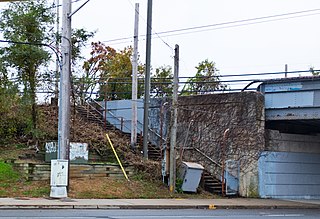
Republic was a station stop along the Ronkonkoma Branch which served employees of the Fairchild Engine & Airplane Manufacturing Company and the nearby Republic Airport from 1940 to the late 1980s. As part of a double-tracking project on the line, the station may be reopened.

Jamesport was a station stop along the Greenport Branch of the Long Island Rail Road in Jamesport, New York. Jamesport's original name was James' Port from the community a mile south of the railroad.
East Yaphank is a proposed station in the hamlet of East Yaphank, New York on the Main Line of the Long Island Rail Road. The station would serve Brookhaven National Laboratory and would replace the existing Yaphank station.


























